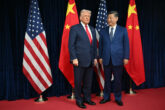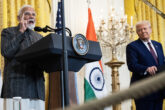
January 25, 2018
Testimony before the U.S.-China Economic and Security Review Commission
The Geostrategic and Military Drivers and Implications of BRI
Commissioner Shea, Commissioner Tobin, thank you for the opportunity to testify before this distinguished commission on “The Geostrategic and Military Drivers and Implications of BRI.”
I commend this commission for convening a daylong hearing on different aspects of China’s Belt and Road Initiative, or BRI. My testimony will focus on the geostrategic and military drivers and implications of BRI, while also touching on the larger elements of an American strategy intended to shape BRI to align with international rules and norms, cooperate selectively with China, and compete smartly where required.
What is BRI, and Why Does It Matter
China is making a trillion-dollar play to shape the economic and geopolitical future of the Indian Ocean rim and Eurasia. Unveiled by Chinese President Xi Jinping in the fall of 2013, what has since become known as the Belt and Road Initiative (though still sometimes referred to as “One Belt, One Road”) is a long-term effort by Beijing to link together parts of Asia, the Middle East, Africa, and Europe through building ports, rails, roads, pipelines, and telecommunications networks, and other types of infrastructure.
Geographically, BRI covers countries representing 65 percent of the world’s population and one-third of its economic output. China plans to spend a trillion dollars in support of the initiative, which at present encompasses two major parts: a “21st Century Maritime Silk Road” stretching from Southeast Asia across the Indian Ocean into the Mediterranean Sea; and, a “Silk Road Economic Belt” extending across Eurasia with branches terminating in Pakistan, Europe, and potentially additional locations. 3 A “Digital New Silk Road” that overlays both the maritime and land corridors with communications technology infrastructure may eventually become a third major part of BRI. The primary drivers behind BRI ultimately relate to China’s domestic economy: the need to relieve surplus industrial capacity, the imperative to promote economic growth in China’s underdeveloped regions through greater international connectivity, and the ambition to transform state-owned enterprises into globally competitive companies. Yet BRI also reflects several geostrategic and military considerations. First and foremost is President Xi Jinping’s vision of national rejuvenation –a China predominant in Asia and the leading power globally by 2049. Longstanding concerns about China’s energy dependence on vulnerable sea lines of communication as well as a desire to stand up new China-centric international organizations also motivate BRI.
Despite some recent high-profile setbacks to several BRI projects, China at present retains the initiative. And the United States should neither underestimate China’s ability to implement the vision articulated for BRI nor downplay the appeal of BRI to countries in dire need of investment in physical and digital infrastructure. In late 2013, a lack of imagination prevented the United States from anticipating the scope and consequences of Beijing’s land reclamation in the South China Sea, delaying a timely and vigorous response. By comparison, BRI is unfolding over a far larger land and maritime expanse, and could have more sweeping consequences for the United States.
The full testimony is available to download and can be watched here.
Download the testimony.
More from CNAS
-
Indo-Pacific Security / Energy, Economics & Security
How to Win the Economic War with ChinaTrump's approach to China has run aground, giving Beijing unprecedented advantage in the economic conflict....
By Edward Fishman & Julian Gewirtz
-
America’s Self-Loathing Is a Losing Hand
This article was originally published in The Washington Post.Around 10 years ago, the United States began a historic shift in its grand strategy toward China, abandoning the b...
By David Feith
-
Indo-Pacific Security / Energy, Economics & Security / Technology & National Security
Selling AI Chips Won’t Keep China Hooked on U.S. TechnologyU.S. policy should not rest on the illusion that selling chips can trap China inside the American tech ecosystem....
By Janet Egan
-
Will New Delhi-Beijing Move Beyond Friction Points? | Ex-White Official On India-China Reset
Prime Minister Narendra Modi on Friday said that India and China, as two major economies, must work together to bring stability to the global economic order. NDTV's Gaurie Dwi...
By Lisa Curtis




